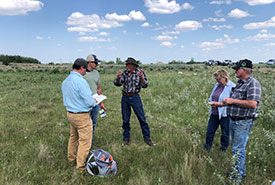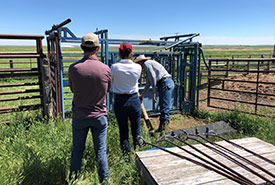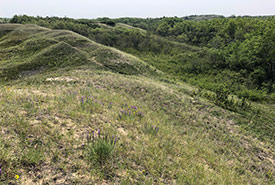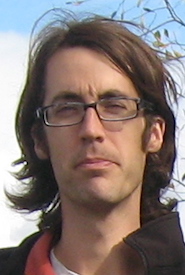Show me the spreadsheet: Unveiling the wonders of working landscapes

NCC Stewardship Coordinator, Casey Rempel, engaging with Aberdeen Pasture patrons during a field event. (Photo by Matthew Braun/NCC staff)
What crazy jobs we have. Did you think when you were a young student that shuffling numbers on a spreadsheet for a school project would be the key bit of experience you’d need for conservation? Yeah, me neither. Let me explain by going on a wild tangent that will hopefully (just like my fabulous spreadsheets) tidily sum everything up and explain how we get great conservation results from all the small things we do.
About a year ago, Nature Conservancy of Canada (NCC) staff in Saskatchewan received an email from a French filmmaker who’d read about NCC’s Old Man on His Back Prairie and Heritage Conservation Area (OMB). He wanted to come to Canada to make a documentary about the Prairies and boreal forests and he needed to connect with some folks and find good locations. The conservation community in Saskatchewan rallied (I was particularly motivated because some of what he learned about NCC came from my blog posts about prescribed fire at OMB. So, in case anyone is asking, yes, flattery works on me.), and his film crew came, shot beautiful footage and created the piece (we’re excited to provide the link as soon as we’re able to share it).
He wrote to me again the other day just to check in and ask if I’d written any blogs lately. As I was reflecting on his question, I got inspired with a story about neat orderly rows and columns of numbers and notes. A few years ago, I was the treasurer for a local charity, where my job was to reimburse approved expenses from our community engagement activities. I could see the amazing stories of lives positively affected by buying groceries, sending kids to summer camp, providing tuition grants to deserving students and supporting the local school’s food drive. There was a powerful story in those receipts and the spreadsheet I was turning them into, but it wasn’t very poetic.

Excel pasture manager, Barney Brice, demonstrating livestock handling equipment during a tour of the pasture. (Photo Matthew Braun/NCC staff)
I was thinking back to those days as I crunched the numbers for NCC’s Working Landscapes program I direct here in Saskatchewan. This program arose out of Michael Bradstreet’s, NCC’s former senior vice-president of new conservation strategies, vision for how NCC could help conserve biodiversity on large landscapes regardless of who owned the land.
NCC started working with like-minded ranchers and farmers that knew that the value of the land they were ranching went beyond livestock production and included environmental and societal benefits. We developed strategies of engagement and trust building that would facilitate infrastructure development to help livestock management while also benefiting the pasture’s native flora and fauna. All this while building a network of farmers and ranchers that saw the conservation community as an ally rather than an advisory.

NCC Stewardship Coordinator, Casey Rempel, engaging with Aberdeen Pasture patrons during a field event. (Photo by Matthew Braun/NCC staff)
So, as I sit reviewing last year’s Working Landscapes activities and people NCC engaged with, I can see the story in a familiar spreadsheet layout of rows and columns. We’ve connected with 340 ranchers, 380 students and volunteers, 24 government employees, and held 53 meetings and events. This work resulted in 22 pasture partners representing around 340,000 hectares in various stages of management plan development. This contributes to other effective area-based conservation measures on a huge scale (700 hectares this spring, 10,000 hectares in the coming year and the potential for 100,000 hectares more). In those numbers, I see the rolling hills of native grassland, with pronghorn and mule deer bounding along, and the grassland songbirds trilling in the wind as they search for nesting sites and mates.
The little acts of conservation we do show up in our notes, calendar invites, emails and spreadsheets. We don’t get the conservation successes without attending meetings, often with coffee and doughnuts, where we have those biodiversity conversations. Visiting the land and getting to know the ranchers and land managers as we work together in conservation is incredible. This is how we are making changes happen within the Working Landscapes Program, and it is an amazing part of delivering NCC’s strategic plan and playing a vital role in the conservation of our natural areas and the species they sustain.


